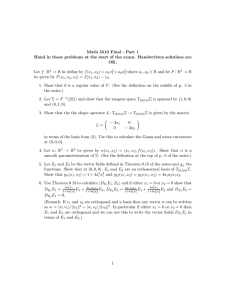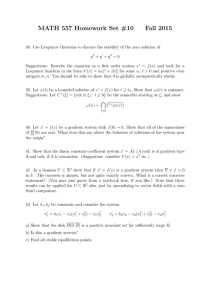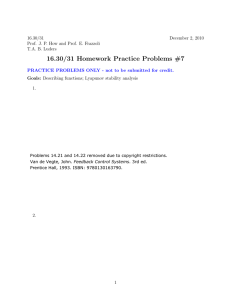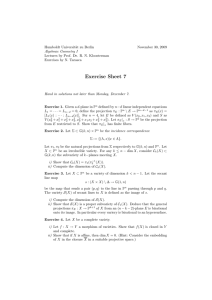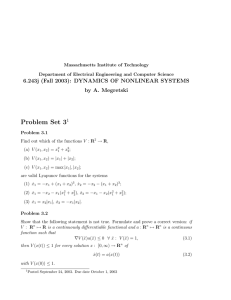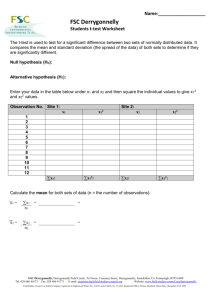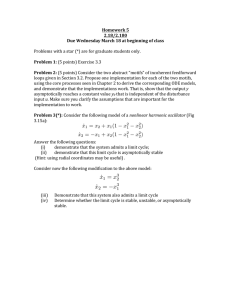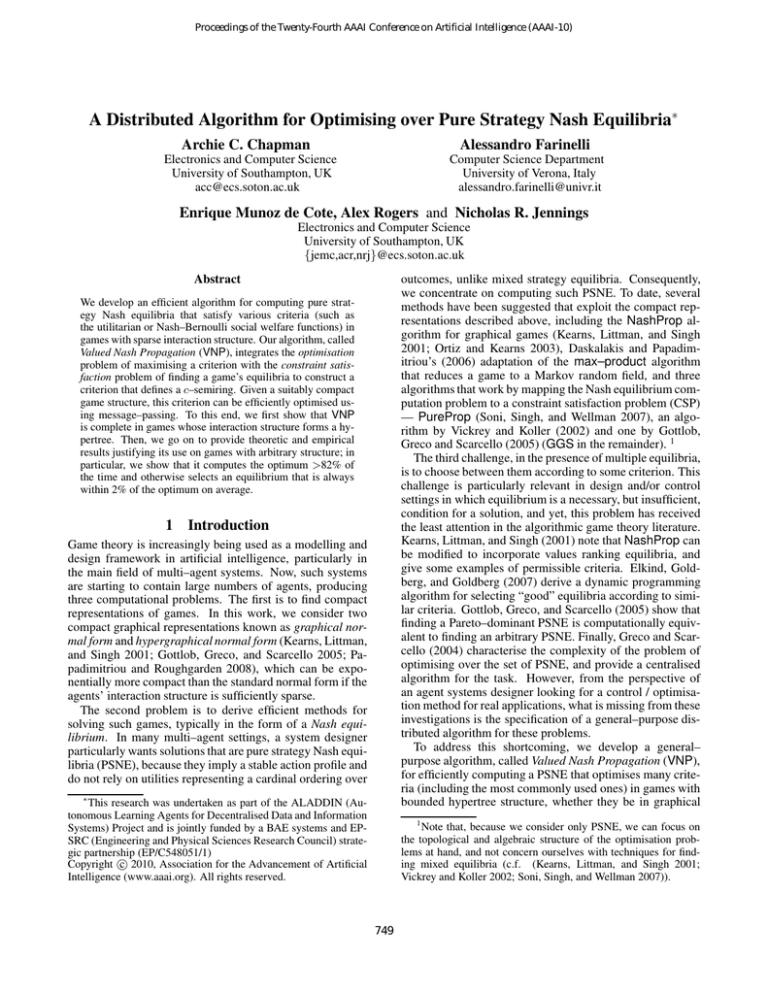
Proceedings of the Twenty-Fourth AAAI Conference on Artificial Intelligence (AAAI-10)
A Distributed Algorithm for Optimising over Pure Strategy Nash Equilibria∗
Archie C. Chapman
Alessandro Farinelli
Electronics and Computer Science
University of Southampton, UK
acc@ecs.soton.ac.uk
Computer Science Department
University of Verona, Italy
alessandro.farinelli@univr.it
Enrique Munoz de Cote, Alex Rogers and Nicholas R. Jennings
Electronics and Computer Science
University of Southampton, UK
{jemc,acr,nrj}@ecs.soton.ac.uk
Abstract
outcomes, unlike mixed strategy equilibria. Consequently,
we concentrate on computing such PSNE. To date, several
methods have been suggested that exploit the compact representations described above, including the NashProp algorithm for graphical games (Kearns, Littman, and Singh
2001; Ortiz and Kearns 2003), Daskalakis and Papadimitriou’s (2006) adaptation of the max–product algorithm
that reduces a game to a Markov random field, and three
algorithms that work by mapping the Nash equilibrium computation problem to a constraint satisfaction problem (CSP)
— PureProp (Soni, Singh, and Wellman 2007), an algorithm by Vickrey and Koller (2002) and one by Gottlob,
Greco and Scarcello (2005) (GGS in the remainder). 1
The third challenge, in the presence of multiple equilibria,
is to choose between them according to some criterion. This
challenge is particularly relevant in design and/or control
settings in which equilibrium is a necessary, but insufficient,
condition for a solution, and yet, this problem has received
the least attention in the algorithmic game theory literature.
Kearns, Littman, and Singh (2001) note that NashProp can
be modified to incorporate values ranking equilibria, and
give some examples of permissible criteria. Elkind, Goldberg, and Goldberg (2007) derive a dynamic programming
algorithm for selecting “good” equilibria according to similar criteria. Gottlob, Greco, and Scarcello (2005) show that
finding a Pareto–dominant PSNE is computationally equivalent to finding an arbitrary PSNE. Finally, Greco and Scarcello (2004) characterise the complexity of the problem of
optimising over the set of PSNE, and provide a centralised
algorithm for the task. However, from the perspective of
an agent systems designer looking for a control / optimisation method for real applications, what is missing from these
investigations is the specification of a general–purpose distributed algorithm for these problems.
To address this shortcoming, we develop a general–
purpose algorithm, called Valued Nash Propagation (VNP),
for efficiently computing a PSNE that optimises many criteria (including the most commonly used ones) in games with
bounded hypertree structure, whether they be in graphical
We develop an efficient algorithm for computing pure strategy Nash equilibria that satisfy various criteria (such as
the utilitarian or Nash–Bernoulli social welfare functions) in
games with sparse interaction structure. Our algorithm, called
Valued Nash Propagation (VNP), integrates the optimisation
problem of maximising a criterion with the constraint satisfaction problem of finding a game’s equilibria to construct a
criterion that defines a c–semiring. Given a suitably compact
game structure, this criterion can be efficiently optimised using message–passing. To this end, we first show that VNP
is complete in games whose interaction structure forms a hypertree. Then, we go on to provide theoretic and empirical
results justifying its use on games with arbitrary structure; in
particular, we show that it computes the optimum >82% of
the time and otherwise selects an equilibrium that is always
within 2% of the optimum on average.
1 Introduction
Game theory is increasingly being used as a modelling and
design framework in artificial intelligence, particularly in
the main field of multi–agent systems. Now, such systems
are starting to contain large numbers of agents, producing
three computational problems. The first is to find compact
representations of games. In this work, we consider two
compact graphical representations known as graphical normal form and hypergraphical normal form (Kearns, Littman,
and Singh 2001; Gottlob, Greco, and Scarcello 2005; Papadimitriou and Roughgarden 2008), which can be exponentially more compact than the standard normal form if the
agents’ interaction structure is sufficiently sparse.
The second problem is to derive efficient methods for
solving such games, typically in the form of a Nash equilibrium. In many multi–agent settings, a system designer
particularly wants solutions that are pure strategy Nash equilibria (PSNE), because they imply a stable action profile and
do not rely on utilities representing a cardinal ordering over
∗
This research was undertaken as part of the ALADDIN (Autonomous Learning Agents for Decentralised Data and Information
Systems) Project and is jointly funded by a BAE systems and EPSRC (Engineering and Physical Sciences Research Council) strategic partnership (EP/C548051/1)
c 2010, Association for the Advancement of Artificial
Copyright Intelligence (www.aaai.org). All rights reserved.
1
Note that, because we consider only PSNE, we can focus on
the topological and algebraic structure of the optimisation problems at hand, and not concern ourselves with techniques for finding mixed equilibria (c.f. (Kearns, Littman, and Singh 2001;
Vickrey and Koller 2002; Soni, Singh, and Wellman 2007)).
749
ture, and prove forms of convergence for the cases of acyclic
and loopy topologies. Following this, in the absence of theoretic guarantees, in Section 5 we empirically evaluate VNP
in games with loopy topologies. Section 6 concludes.
or hypergraphical normal form. Specifically, we develop
two versions of VNP, a complete algorithm for games with
acyclic interaction structure, and an approximate algorithm
for games with loopy topologies. These algorithms can optimise over PSNE using any equilibrium selection criterion
that defines a valuation algebra on a commutative (c–) semiring. One of VNP’s strengths is the diversity of selection
criteria that it can optimise, which makes it suitable for various scenarios in which different criteria might be applied.
Examples include the utilitarian, Nash–Bernoulli and egalitarian social welfare functions, threshold constraints on utility values, (e.g. minimum utility to a set of players), and
the Pareto dominance and p–dominance equilibrium refinements (a generalisation of risk dominance). By so doing,
this work generalises and unifies many of the above strands
of research on computing and ranking equilibria in games
with graphical interaction structure. Our work is inspired
by general results regarding the generalised distributive
law (GDL) family of algorithms (Aji and McEliece 2000;
Kohlas and Wilson 2008), which includes max–product
mentioned earlier, max–sum for distributed constraint optimisation and sum–product for graphical probability models (Farinelli et al. 2008; Wainwright, Jaakkola, and Willsky
2004). The GDL algorithms have been successfully applied
to optimisation problems in agent systems with both tree
and loopy topologies. They are complete for any problem
that has an acyclic structure (either naturally or by generating a tree decomposition) and, furthermore, they run efficiently on problems with bounded tree–width. However, the
GDL algorithms themselves cannot be used for equilibrium
selection in games because they do not compute equilibria.
In contrast, VNP explicitly considers best responses alongside an ordering over outcomes, and in so doing, interleaves
equilibrium computation with the optimisation problem of
ranking equilibria.
Like the GDL algorithms, VNP uses a two–phase message passing scheme. In the first phase, tables are exchanged between neighbouring agents indicating the value
of each local joint strategy. This data structure is similar
to that of NashProp and Elkind et al.’s algorithm, which
are themselves closely related to max–sum (due to their
common origins in dynamic programming), however, VNP
deals explicitly with hyperedges, and, uniquely, can operate
on games in graphical or hypergraphical normal form. In
the second phase of VNP, strategy assignments are passed
through a spanning tree, ensuring all agents agree on a particular solution, in a manner reminiscent of value propagation in dynamic programming. Specifically, we derive two
versions of VNP; a complete algorithm for hypertree games,
and an approximate algorithm for games with loopy interaction structure. Furthermore, in the absence of theoretic guarantees, we empirically validate the use of the second version
on games with loopy interaction structure.
The paper progresses as follows: In the next section
we review relevant background material on noncooperative
games, introduce the graphical and hypergraphical normal
form representations, and in Section 3 we discuss the criteria computable by VNP. Then, in Section 4, we describe the
operation of VNP on games with sparse interaction struc-
2 Noncooperative Games
A noncooperative game in standard normal form is a tuple, Γ = hN, {Ai , ui }i∈N i, consisting of a set of agents
N = {1, . . . , n}, and for each agent i ∈ N , a set of
(pure) strategies or actions, Ai , with joint strategy space
A = ×N
i=1 Ai , and a utility function ui : A → R. We use
the notation a = {ai , aνi }, where νi is the set of i’s neighbours, which in this representation is N \ i. An agent’s goal
is to maximise its payoff, and its best response, Bi (aνi ),
is the set of i’s best strategies given its neighbours’ strategies: Bi (aνi ) = arg maxai ∈Ai ui (ai , aνi ). Stable points
are characterised by the set of Nash equilibria, which are
defined as those joint strategy profiles, a∗ , in which no individual has an incentive to change its strategy:
ui (a∗i , a∗νi ) − ui (ai , a∗νi ) ≥ 0 ∀ ai ∈ Ai , ∀ i ∈ N.
As such, the Nash equilibrium condition can be expressed
as the sum of a set of indicator functions, I{ai ∈ Bi (aνi )},
each equal to 0 when an agent plays a best response and −∞
otherwise:
"
#
X
max[V (a)] = max
I{ai ∈ Bi (aνi )}
(1)
a∈A
i∈N
This criterion is equal to 0 if a is a PSNE and −∞ elsewhere.
2.1 Compact Graphical Forms of Games
We begin with the requisite graph theory, before moving on to the graphical and hypergraphical normal form
game representations. In more detail, an undirected graph
G = hN, Ei is composed of a set of nodes (agents), N =
{1, . . . , n}, connected by a set of edges, E. Building on this,
a hypergraph H = hN, Ei is composed of a set of nodes, N ,
and a set of hyperedges, E, in which E ⊆ P(N ), i.e. a hyperedge e ∈ E is a subset of the nodes. A graph is a hypergraph in which all hyperedges contain two nodes. Here we
only consider simple (i.e. no duplicate edges or self–loops)
connected hypergraphs.
Because of their algorithmic benefits, we are particularly
interested in acyclic graphs and hypergraphs, or trees and
hypertrees. Trees are oriented around a root, and have the
property that each node (except for the root) has one parent. A node can have any number of descendants, and those
without descendent are called leaves. Regarding hypertrees,
we rely on classical acyclicity (c.f. α–acyclicity (Beeri et al.
1983; Gottlob, Greco, and Scarcello 2005)). This is defined
in reference to a hypergraph’s vertex–hyperedge incidence
graph: a bipartite graph with one set of nodes containing
the nodes of the hypergraph and the second containing the
hyperedges. A hypergraph is acyclic if its vertex–hyperedge
incidence graph is a tree (as in Fig 1), and the leaves of this
graph are called the leaves of the hypergraph.
750
A
γ1
E
A
γ4 F
B
C
γ3
γ2
B
padimitriou and Roughgarden 2008). Many computational
situations arising in control settings naturally possess hypergraphical structure, particularly those in which neighbours
are specified with reference to a physical domain in which
interactions are dependent on some degree of physical proximity (e.g. mobile sensors, UAVs, or job scheduling problems). As for the graphical normal form, an acyclic hypergraphical form game is one whose local game hypergraph is
acyclic (as shown in Fig 1).
γ1
C
γ3
E
γ2
D
D
γ4
F
(a)
(b)
Figure 1: (a) An acyclic hypergraph and (b) its bipartite vertex–
hyperedge incidence tree. Circles are agents, A to F , and hyperedges and squares are dependency hyperedges (graphical form)
or local games (hypergraphical form), γ1 to γ4 .
3
Equilibrium Selection Criteria
In general, any criterion that defines a c–semiring can be
computed by VNP, and many selection criteria have this
form. In more detail, a commutative semiring (c–semiring)
is a tuple hK, ⊕, ⊗i defining a carrier, K, and two binary
operations ⊕ and ⊗. These operations possess identities in
K and satisfy the following two rules: (i) ⊗ distributes over
⊕ (i.e. x ⊗ (y ⊕ z) = x ⊗ y ⊕ x ⊗ z) and (ii) both are
commutative (e.g. x ⊗ y = y ⊗ x) for any x, y, z ∈ K.
One commonly–employed equilibrium selection criterion
is the utilitarian social welfare function (SWF), which selects the PSNE that maximises the sum of the agents’ utilities. We can construct a criterion for this problem by augmenting the PSNE criterion (Eq 1) with the utilitarian SWF:
"
#
X
max[V (a)] = max
I{ai ∈ Bi (aνi )} + ui (ai , aνi )
Graphical Normal Form Games in graphical normal
form are represented by a graph on which each agent i is located at a node. An agent is connected to those with which
it shares an undirected utility dependency, which make up
its set of neighbours νi ⊆ N . Its utility function is given
by an array indexed by tuples from the set ×j∈{i,νi } |Aj |. If
the game–graph is sufficiently sparse, this representation is
exponentially more compact than the standard normal form
(Kearns, Littman, and Singh 2001). We can extend this
model to one in which cliques and loops are modelled by
hyperedges. Specifically, we say that a hyperedge of a game
in graphical form contains a subset of the agents, γ ∈ P(N ),
and the set of agents in γ is written N γ . We denote the set
of hyperedges containing i by Γi , the neighbours of i by
νi = ∪γ∈Γi N γ \ i, and i’s neighbours in a particular hyperedge, γ, by νiγ = N γ \ i. Finally, we say that a game in
graphical form is tree–structured if its game graph forms a
tree, and is hypertree–structured if the game hypergraph is
acyclic (see Fig 1).
a∈A
a∈A
i∈N
(2)
This criterion returns −∞ if a profile that is not a PSNE
is played, and the sum of the agents’ utilities when one is
played. Consequently, it defines a valuation algebra on the
tropical semiring, h{R ∪ −∞}, max, +i. Furthermore, the
image set of the indicator functions, {0, −∞}, are the idempotent elements of {R∪−∞}, and the value returned if ai is
not a best response is absorbing under addition. In general,
in terms of the abstract operators defined earlier, max and +
correspond to ⊕ and ⊗, and the indicator function returns a
value that either annihilates (and absorbs under ⊗) the value
in that element of the table if it is not a best response, or
leaves the value unchanged if it is a best response. Any selection criteria with this form can be optimised using VNP;
two further examples are the egalitarian SWF and Nash–
Bernoulli product (Elkind et al., 2007, give more examples
of criteria fitting this form). The former ranks equilibria according to the minimum utility received by any agent, and
employs an indicator function that returns ∞ if ai is a best
response and −∞ if it is not. The latter aggregates individual utilities by multiplication, with an indicator function
returning 1 for a best response and zero otherwise.
Hypergraphical Normal Form Hypergraphical normal
form is used to represent noncooperative games that
can be decomposed into several local games: Γ =
{γ1 , γ2 , ..., γm }.2 In this representation, nodes of a hypergraph correspond to the set of agents, while the hyperedges
directly represent local games played between them (see
Fig 1). Specifically, each hyperedge is a game in standard
normal form: γ = hN g , {Ai , ugi }i∈N g i, where N g ⊆ N are
the set of agents playing γg and ugi : Ag → R is the payoff to i from its involvement in γg , where Ag = ×j∈N g Aj .
Agents are usually involved in more than one local game,
with the set of local games in which i is involved denoted
Γi . For each agent, ai represents i’s global strategy, which
is the same in each local game. Agent i’s neighbours are
the agents that it shares at least one local game with, defined as νi = ∪γg ∈Γi N g \ i, and i’s neighbours in γg are
νig = N g \ i. Agent i’s payoff for an outcome is an aggregation of its payoffs from each γg ∈ ΓP
i , typically the sum
g
g
of payoffs from each: ui (ai , aνi ) =
γg ∈Γi ui (ai , aνi ).
If the agents’ utilities from different interactions separate
into many local games, then the entire representation can
be exponentially smaller than the standard normal form (Pa-
4 The VNP Algorithm
VNP operates using a two–phase message–passing sequence, called table–passing and assignment–passing. As
message–passing on loopy topologies is inherently more
complicated, in what follows we distinguish between the
tree and loopy hypergraph cases. Specifically, in Section 4.1
we describe the table–passing phase, which is the key component of VNP, and prove a form of convergence for each
2
We use the same notation for hyperedges in both the graphical
and hypergraphical forms because, from an algorithmic perspective, the two types of hyperedges are treated the same way, even
though they do not necessarily represent identical relationships between the agents.
751
case. Then, in Section 4.2 we describe the assignment passing phase, and prove that a single criterion–maximising outcome is selected by the agents on hypertrees, and that if
the table–passing phase converges, a high value PSNE is selected on loopy hypergraphs. For reference, pseudocode of
VNP’s phases on hypertrees is given in Fig 2, and an example of its operation is given in Chapman et al. (2010).
When the termination condition for the table–passing
phase is met, agent i uses the messages it received from its
neighbours to construct the following function:
4.1
Next, we show that the above result is equal to the equilibrium selection criterion (Eq 2) in games with hypertree
interaction structure (Theorem 1), while with loopy structure, the values of non-PSNE local profiles converge to the
annihilating element of the semiring (Theorem 2).
Vi (ai , aνi ) =I{ai ∈ Bi (aνi )} + ui (ai , aνi )
X X
Tj→i (ai , aνig )
The Table–Passing Phase
In this phase, agents exchange tables with their neighbours
in each hyperedge. These tables contain values which succinctly represent the value of the ranking of each joint strategy of the hyperedge’s agents. Although VNP’s message–
passing schedule and termination condition for games on
hypertrees differ from that for loopy hypergraphs, the data
structures and the operations used to construct the values in
the messages are common to both. As such, we now detail the common elements, and then discuss the respective
message–passing schedules and forms of convergence for
hypertrees and loopy hypergraphs independently.
The messages exchanged in the table–passing phase are
an array, indexed by the joint strategy space of the agents in
the hyperedge common to both sender and recipient. Specifically, i passes
Q to its neighbour j in hyperedge γg an array
Ti→j with k∈N g |Ak | entries, indexed by an ordered |N g |–
tuple representing a joint strategy of the agents in γg . An element of a message is denoted Ti→j (ai , aνig ). Agents store
the messages they receive for use in the second phase.
Using the notation of Eq 2, elements of the message i
sends to j are computed by:
"
On Hypertrees Table–passing begins with messages sent
from the leaves of the hypergraph. Each internal node then
computes and sends messages to its neighbours in a particular local game γg once it has received messages from
all of its neighbours outside γg . After it receives messages
from all of its neighbours, i constructs the function given in
Eq 4. By computing the maximum value of Eq 4 (i.e. over
{ai , aνi }), i finds a local configuration that maximises Eq 2.
Theorem 1 The table–passing phase of VNP produces the
value of the relevant c–semiring criterion for each local pure
strategy profile in a hypertree–structured game.
The proof is by induction, and is available in Chapman
et al. (2010). If the solution is unique or doesn’t exist,
then the table’s values show this unambiguously, and each
agent selects its strategy without requiring an assignment–
passing phase. However, if more than one solution exists, the agents coordinate on a solution using assignment–
passing (discussed in Section 4.2).
Ti→j (ai , aνig ) = max I{ai ∈ Bi (aνig , aν −g )}
a
ν
i
i
−g
i
+ ui (ai , aνig , aν −g )
(4)
γg ∈Γi j∈νig
X
X
γh ∈Γi \γg k∈νih
On Loopy Hypergraphs Even though the table–passing
phase of VNP is only provably optimal on acyclic hypergraphs, we may, want to deploy it on loopy hypergraphs.
Fortunately, max–sum and NashProp perform well on
such topologies (Farinelli et al. 2008; Ortiz and Kearns
2003), and because of its similarity to these algorithms, we
conjecture that VNP will also perform well on loopy hypergraphs (see Section 5 for more details). However, this
necessitates changes to the message schedule and termination condition of the table–passing phase as described for
hypertrees.
The message–passing schedule used on arbitrary topologies is a “flood” schedule, whereby every agent sends a message at each time step (this is not the only option, but has
been used to good effect in Farinelli et al. (2008) and Ortiz and Kearns (2003)). The agents begin by initialising all
elements of their “stored” messages to 0 (or the identity of
⊗ in the relevant semiring). Then, at each time step t, they
simultaneously compute messages according to Eq 3, and
send them to their neighbours.
Now, loops in the hypergraphs prevent us from explicitly
calculating the value of the criterion. Nonetheless, we can
put a weaker guarantee on the values in the messages passed
by VNP in loopy graphs, and consequently the value of each
t
agent’s local version of the criterion (Eq 4). Let Ti→j
be the
message passed from i to j at time t. Call a message entry
#
Tk→i (ai , ak , aνkh \i )
(3)
where νi−g = νi \ νig . The operations above perform two
processes. First, for a fixed joint strategy (ai , aνig ) in γg ,
the summations combine the value of the joint strategy of
the agents in all of the hyperedges containing i except γg
(i.e. Γi \ γg ) to give rankings to each joint strategy of i’s
neighbours outside of γg . In this combination, the indicator
function sets the entries to the annihilating element of the
semiring if the joint strategy is not in equilibrium with ai .
Second, the maximisation then summarises the information
regarding aν −g and projects the information onto the fixed
i
joint strategy in γg . If there is no equilibrium associated
with ai , then the output is the annihilating element. Now,
to complete the maximisation component, an agent needs
to sum messages regarding strategies of different agents. To
do this, the agent extends each incoming message to the joint
strategy space of all incoming messages, by combining the
relevant message entries to give a value for the respective
joint strategy. As an example, consider Fig 1, in which C
would extend messages it received from A and B to |AA | ×
|AB | × |AC | and then perform the maximisation.
752
Although we have proven a form of convergence for
table–passing on loopy graphs, it is not possible to precisely
define a termination condition for this phase. A partial condition is that table–passing should terminate if all of the
messages being passed converge. However, this cannot be
known beforehand, so, in its absence, this phase should allow sufficient time for the values in the messages passed by
the agents to converge, if indeed they are going to converge
(details of our implementation are presented in Section 5).
Function vnpTablePassing(Γi )
for each hyperedge g : Γi ,
if values Tj→i have been received from all neighbours outside g, j ∈ νi−g ,
compute Ti→j for neighbours in g, j ∈ νig ;
send Ti→j to neighbours in g, j ∈ νig ;
end if
end for
Function vnpAssignmentPassing(Γi , Tj→i ∀j ∈ νi )
if an assignment Sj→i has been received from any neighbour, j ∈ νig ∀g ∈ Γi ,
for each hyperedge g : Γi ,
if no neighbour k ∈ g has sent a message Sk→i ,
compute Si→k for neighbours in g, k ∈ νig ;
send Si→k to neighbours in g, k ∈ νig ;
end if
end for
end if
4.2 The Assignment–Passing Phase
Once the termination condition for the table–passing phase
has been satisfied, the function in Eq 4 is computed and each
agent uses it to decide on a strategy. If a unique solution (or
the non–existence of one) is not evident at the end of the
table–passing phase, then the agents coordinate on a single
solution using an assignment–passing phase. As before, we
need to use different approaches on hypertrees and loopy hypergraphs, and the two cases are discussed separately below.
Figure 2: Pseudocode of each phase of VNP on a hypertree.
eliminated if it equals −∞ (or the annihilating element of
the semiring in use) and valued otherwise.
On Hypertrees To begin, a spanning tree is constructed,
emanating from an arbitrarily selected root node, down
which parents pass messages containing local strategy profiles to their descendent This tree is built by first connecting
the root to all of its neighbours. A particular agent, i, which
interacts with the root through γg , is either a leaf or an internal node involved in other hyperedges. If it is an internal
node, then it is the only agent that appears in both γg and
any of its other hyperedges (by the definition of acyclicity).
As such, the spanning tree is extended by connecting i to all
of its neighbours except those in γg , and so on.
Given this spanning tree, the root randomly selects a local strategy profile corresponding to one maximum of its
version of Eq 4. For the root node, the action is given by
argmaxai ,aνi [Vi (ai , anui )]. It then sends messages, Sr→i
to its neighbours in each hyperedge, i ∈ N γg , containing
the local strategy, aN g , for γg . In other words, the root selects a complete strategy profile for each of its hyperedges
and directs each neighbour to play its element of this profile. As for the table–passing computations, this operation
is polynomial in the size of the local joint action space of
a player in both the graphical and hypergraphical representations of the game. For an internal i, ai and some of the
actions in aνi will be assigned by the agent’s parent node,
so the argmax operation is carried out over only the unassigned variables In hyperedges with three or more agents,
this is necessary to avoid mis–coordination between two of
the root’s neighbours, because more than one optimal joint
strategy could be associated with the root’s strategy. Then i
selects a joint strategy for all of its hyperedges except γg that
both maximises its version of Eq 4 and contains the strategy
assigned to it by the root, choosing randomly between equivalent strategies. It sends Si→j strategy assignments to all of
its unassigned neighbours j. This process continues until
each leaf of the spanning tree is assigned a strategy by its
parent. At this point, all agents have been assigned a strategy and the algorithm terminates. Conceivably, the spanning tree could be constructed and the strategies propagated
as part of one process.
Theorem 2 For VNP on a game with arbitrary topology,
as t → ∞, a message entry is valued if and only if it corresponds to local strategy profile that is a PSNE.
The proof is sketched as follows:3 First, for sufficiency,
let a∗ be a PSNE profile. Then for all t ≥ 0, all message elements corresponding to the subset of a∗ in γg ,
t
Ti→j
(a∗i , a∗ν g ), are valued. This can be shown to be true
i
by induction: For t = 0 it is true by the initialisation of
the stored messages, and then for any t > 0, any entry of
a message sent to j corresponding to a∗ is valued, and j itself will never eliminate that entry, so it is true for all t, and
therefore true for the limit messages. Thus we have proved
the sufficient condition. Second, to prove necessity, note
that once an entry in a stored message is eliminated, it cannot become valued again. Consequently, because any global
profile that contains at least one action that is not a best response is eliminated at some t < ∞, any valued entry in a
stored message that does not correspond to a PSNE profile
is also eliminated.
In other words, in the limit, Eq 4 is only valued for local profiles corresponding to a PSNE, and, therefore, when
the assignment–passing phase selects an outcome based on
Eq 4, it is always a PSNE. Furthermore, if no PSNE solution exists, then the algorithm will report this fact because
all the entries in all the messages will converge to the annihilating element. However, because the values of the (non–
eliminated) entries in the tables do not necessarily converge
to the true values of Eq 2, the equilibrium selected by the
agent may not maximise the criterion. Nonetheless, we expect that the equilibrium selected should still do very well
by the criterion, and test this hypothesis in Section 5, where
we run VNP on a batch of loopy hypergraphical games.
3
Our proof follows a similar argument to that of Ortiz and
Kearns (2003) for the convergence of messages in the NashProp
algorithm in loopy graphical games.
753
Lemma 1 The assignment–passing phase of VNP for hypertrees assigns each agent a strategy corresponding
to a single criterion–maximising PSNE in a hypertree–
structured game.
Figure 3: Example of the chordal
topology used in the experiments.
The proof is omitted for brevity, but follows the same argument for the max–product algorithm presented in Wainwright, Jaakkola, and Willsky (2004). However it should
be clear from the above that, by induction, the root’s choice
propagates through the width–first spanning tree without any
mis–coordination of agents’ strategies. Combining Theorem 1 and Lemma 1 gives us the following result.
Evaluation of VNP on Loopy Hypergraphs
5
The purpose of this section is to demonstrate, in the absence
of theoretic guarantees, the efficacy of VNP on games with
sparse but cyclic topologies. Specifically, we use a set of hypergraphical games with chordal topology, following Ortiz
and Kearns (2003). These games have sparse–enough topology to demonstrate how VNP exploits structure (because
each agent has a limited number of neighbours), but at the
same time are sufficiently cyclic to make the exact computation of a criterion infeasible for large problems. The games
are constructed using a generic topology, shown in Fig 3,
comprising (i) a ring of 3–player, 2–action local games, such
that every second agent is contained on two hyperedges and
the games form a single cycle, and (ii) chord games, linking
pairs of agents that are only in one ring game (which limits the number of hyperedges any one agent is on to two).
The payoffs in the local games are constructed such that
they possess several pure equilibria, however, the ranking
over these equilibria varies according to randomly chosen
payoffs in the chord games. More details of the experiment
generating process are available in Chapman et al. (2010).
We compared VNP for loopy topologies to an optimal
‘brute force’ version of VNP that does not exploit any graphical structure, in which each agent constructs a joint message
to every other in the system and so maximise Eq 2 directly.
We did not benchmark against existing approaches because
ours is the only algorithm that optimises over any c–semiring
criterion; indeed we could have cast VNP as an extension
to either NashProp or GGS for the purpose of optimising
over equilibria in games with sparse hypergraphical interaction structure. As such, our experiments only aim to prove
the efficacy of VNP.
We ran 100 iterations for each size game. We say an algorithm has converged when the optimal strategies of the
agents have not changed for 10 time steps, and recorded the
convergence time as the last of these steps. We also recorded
the average processing time the algorithm took to converge5,
the proportion of runs that converge to an optimum and, for
the remaining suboptimal solutions, the average ratio of the
optimal solution’s value over the suboptimal solution.
The results of these experiments are reported in Fig 1.
Regarding the quality of the solutions generated, they show
that VNP computes the optimal solution with a very high
frequency (always greater than 82% of runs). Furthermore,
when a sub–optimal equilibrium is selected, its value is typically very close to that of the optimum (always within 2%).
In terms of the computation time required to generate a solu-
Theorem 3 In acyclic graphical and hypergraphical
games, for any selection criterion that defines a valuation
algebra on a c–semiring, VNP computes an optimal PSNE.
Additionally, if the number of neighbours and the number
of hyperedges each agent has is bounded, VNP is polynomial in the total number of agents, because each local computation is polynomially bound.4 Finally, on a hypertree, the
number of messages exchanged in order to carry out both
phases of computation in VNP is at most r + s steps, where
r is the diameter of the game hypertree and s is the length of
the longest path from root to leaf in the assignment spanning
tree (if an assignment–passing phase is required).
On Loopy Hypergraphs On loopy hypergraphs, if more
than one solution exists and/or table–passing does not converge, then the agents must use a more sophisticated strategy
assignment procedure than on acyclic hypergraphs. Again,
the first step is to build a spanning tree, in the same manner
as for acyclic topologies, with the additional condition that
an agent only links to its unconnected neighbours.
However, the presence of loops may mean that neighbours in the game may have different parents in the spanning tree. Then, in the case of multiple optimal solutions,
if the procedure for hypertrees described earlier is followed,
these agents may be assigned conflicting strategies by different branches of the spanning tree. To avoid this, we use
a backtracking search over the spanning tree. By this approach, a partial solution is constructed as described earlier,
beginning with the root node optimising its version of Eq 4
and sending its neighbours the corresponding local strategy.
This process continues until any agent identifies a conflict
in the strategies assigned to it or one of its neighbours (i.e.
a non–equilibrium profile is identified). If this occurs, the
search backtracks to a point where the conflict can be resolved, and then begins propagating a solution again. However, the search process can take an exponentially long time
to complete in the case of hypergraphs with many cycles.
Overall, the VNP algorithm on games with arbitrary
structure will never return a solution that is not a PSNE, and
we expect it to provide solutions that approximately optimise the criterion in question. To justify this claim, we now
provide an empirical evaluation of VNP on loopy games.
4
Gottlob, Greco, and Scarcello (2005) prove this for arbitrary
and Pareto PSNE computation on α–acyclic hypergraphs. In contrast, when ranking equilibria by a c–semiring criterion, the correctness of the computation only holds for classical acyclicity.
5
Experiments were carried out on a 3.2GHz desktop PC running
Java, with all processes run in sequence. As such, processing times
were recorded as a relative measure only.
754
Agents
4
8
12
16
20
24
Conv Steps
15.4 (0.32)
17.6 (0.52)
19.1 (0.69)
20.1 (0.83)
21.1 (0.83)
21.9 (1.30)
Time (ms)
64 (5.8)
163 (7.2)
273 (10.7)
428 (17.1)
554 (21.6)
623 (29.9)
% Optimal
94% (4.8)
91% (5.8)
87% (6.8)
84% (7.4)
82% (7.8)
87% (6.8)
Opt/Subopt
1.021 (0.0033)
1.010 (0.0025)
1.014 (0.0014)
1.011 (0.0018)
1.007 (0.0012)
1.013 (0.0017)
Table 1: Message steps to converge, time to converge, proportion converging to an optimal solution and the average ratio of
the optimum over the value of suboptimal solutions (standard
errors in brackets).
Figure 4: Convergence time (ms) versus number of agents,
comparing VNP for loopy topologies to a brute force version
of VNP that does not exploit interaction structure.
tion, the number of message–passing steps to find an equilibrium increases linearly with the number of agents. Furthermore, the actual computation time grows at a polynomial
rate, which is in an artefact of the chordal topology with
bounded number of neighbours we run the experiments on.6
In order to better demonstrate the scalability of VNP if each
agent’s number of neighbours is bounded, in Fig 4 we plot
VNP’s computing time as the number of agents increases,
compared to the brute force version. It shows that VNP’s
processing time increases at a rate that is orders of magnitude less than the brute force algorithm. Indeed, the processing time of the brute force approach follows an almost
perfect exponential relationship with the number of agents
in the problem, while VNP follows a polynomial relationship. Based on the theoretical properties of VNP discussed
earlier (at the end of Section 4.2), we expect that these scaling results will genearlise in a similar fashion to problems
with greater local neighbourhood size (i.e. the polynomial
degree of the computation time should grow linearly with
increases in the local neighbourhood size), and should also
be invariant to the number or size of loops in the problem.
References
Aji, S. M., and McEliece, R. J. 2000. The generalized distributive
law. IEEE Trans. Inform. Theory 46:325–343.
Beeri, C.; Fagin, R.; Maier, D.; and Yannakakis, M. 1983. On the
desirability of acyclic database schemes. J. ACM 30(3):479–513.
Chapman, A. C.; Farinelli, A.; de Cote, E. M.; Rogers, A.; and Jennings, N. R. 2010. Appendix to A Distributed Algorithm for Optimising over Pure Strategy Nash Equilibria . Available at http://
www.ecs.soton.ac.uk/people/acc/publications.
Daskalakis, C., and Papadimitriou, C. H. 2006. Computing pure
Nash equilibria via Markov random fields. In ACM EC ’06.
Elkind, E.; Goldberg, L. A.; and Goldberg, P. W. 2007. Computing
good Nash equilibria in graphical games. In EC ’07, 162–171.
Farinelli, A.; Rogers, A.; Petcu, A.; and Jennings, N. R. 2008.
Decentralised coordination of low-power embedded devices using
the max-sum algorithm. In AAMAS ’08, 639–646.
Gottlob, G.; Greco, G.; and Scarcello, F. 2005. Pure Nash equilibria: Hard and easy games. JAIR 24:357–406.
Greco, G., and Scarcello, F. 2004. Constrained pure Nash equilibria in graphical games. In ECAI ’04.
Kearns, M.; Littman, M. L.; and Singh, S. 2001. Graphical models
for game theory. In UAI ’01, 253–260.
Kohlas, J., and Wilson, N. 2008. Semiring induced valuation
algebras: Exact and approximate local computation algorithms.
Art. Int. 172(11):1360–1399.
Ortiz, L. E., and Kearns, M. J. 2003. Nash propagation for loopy
graphical games. In Becker, S.; Thrun, S.; and Obermayer, K., eds.,
NIPS, volume 15, 793–800.
Papadimitriou, C. H., and Roughgarden, T. 2008. Computing correlated equilibria in multi–player games. J. ACM 55(3):14–29.
Soni, V.; Singh, S.; and Wellman, M. P. 2007. Constraint satisfaction algorithms for graphical games. In AAMAS ’07, 423–430.
Vickrey, D., and Koller, D. 2002. Multi-agent algorithms for solving graphical games. In AAAI ’02, 345–351.
Wainwright, M.; Jaakkola, T.; and Willsky, A. 2004. Tree consistency and bounds on the performance of the max-product algorithm
and its generalizations. Stat. and Comp. 14(2):143–166.
6 Conclusions
We have developed the VNP algorithm for computing PSNE
that optimise various social welfare criteria in games with
bounded hypergraphical structure. We have shown how to
integrate the optimisation problem of finding the maximal
element of a valuation algebra with the constraint satisfaction problem of finding a game’s PSNE. We have also
demonstrated that if the agents in a hypergraphical game
each have a bounded number of neighbours and the game
hypergraph has bounded hypertree–width, then the problem
can be solved efficiently by VNP. In so doing, we have completely characterised the types of problems that can be addressed by algorithms of VNP’s form, and provided two
variants of VNP for different topologies. To round out research on VNP, future work will focus on developing a
complete version for loopy graphs that operates without first
forming a junction tree and deriving analogous convergence
results for VNP to those regarding specific topologies and
attenuated messages for the GDL algorithms.
6
Note that NashProp would compute an arbitrary PSNE in
a similar number of steps, however, the computation time would
likely be less because it does not use floating point operations.
755

